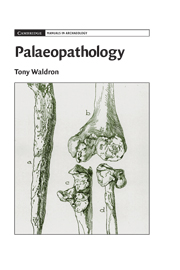Book contents
- Frontmatter
- Contents
- List of Figures
- Preface
- 1 Introduction and Diagnosis
- 2 Bone Metabolism and Pathology
- 3 Diseases of Joints, Part 1
- 4 Diseases of Joints, Part 2
- 5 Bone forming and DISH
- 6 Infectious Diseases
- 7 Metabolic Diseases
- 8 Trauma
- 9 Tumours
- 10 Disorders of Growth and Development
- 11 Soft Tissue Diseases
- 12 Dental Disease
- 13 An Introduction to Epidemiology
- Select Bibliography
- Index
- References
12 - Dental Disease
Published online by Cambridge University Press: 05 June 2012
- Frontmatter
- Contents
- List of Figures
- Preface
- 1 Introduction and Diagnosis
- 2 Bone Metabolism and Pathology
- 3 Diseases of Joints, Part 1
- 4 Diseases of Joints, Part 2
- 5 Bone forming and DISH
- 6 Infectious Diseases
- 7 Metabolic Diseases
- 8 Trauma
- 9 Tumours
- 10 Disorders of Growth and Development
- 11 Soft Tissue Diseases
- 12 Dental Disease
- 13 An Introduction to Epidemiology
- Select Bibliography
- Index
- References
Summary
Teeth generally survive well and provide an important source of information not only about dental disease, but also the use of teeth as tools, and social habits such as artificial deformation. Tooth wear is widely used as means of ageing skeletons. The diseases considered here include dental caries, ante-mortem tooth loss, periodontal disease, dental abscesses, calculus and enamel hypoplasia. A brief account will also be given of dental tumours.
CARIES
Caries is the most common cause of oral pain and tooth loss. It has almost certainly affected humankind from earliest times, although the site of the disease on the tooth has changed in relation to changes in the diet. Briefly, before the introduction of sugar into the diet, caries tended to appear at the cemento-enamel junction, or the appositional surfaces. Once sugar was widely available it affected the fissures on the molars more frequently than elsewhere, and this is the pattern that continues to this day although the widespread fluoridation of drinking water has reduced the prevalence of caries very considerably. Those who can remember how painful caried teeth can be will not be surprised that attempts at treatment have an extremely long history. Fillings have a long usage often involving soft and easily malleable materials such as lead or tin, and amalgam fillings – a solution of one or more metals in mercury – were introduced in the early nineteenth century while nowadays, mercury-free fillings are gaining increasingly in popularity.
- Type
- Chapter
- Information
- Palaeopathology , pp. 236 - 248Publisher: Cambridge University PressPrint publication year: 2008
References
- 1
- Cited by



